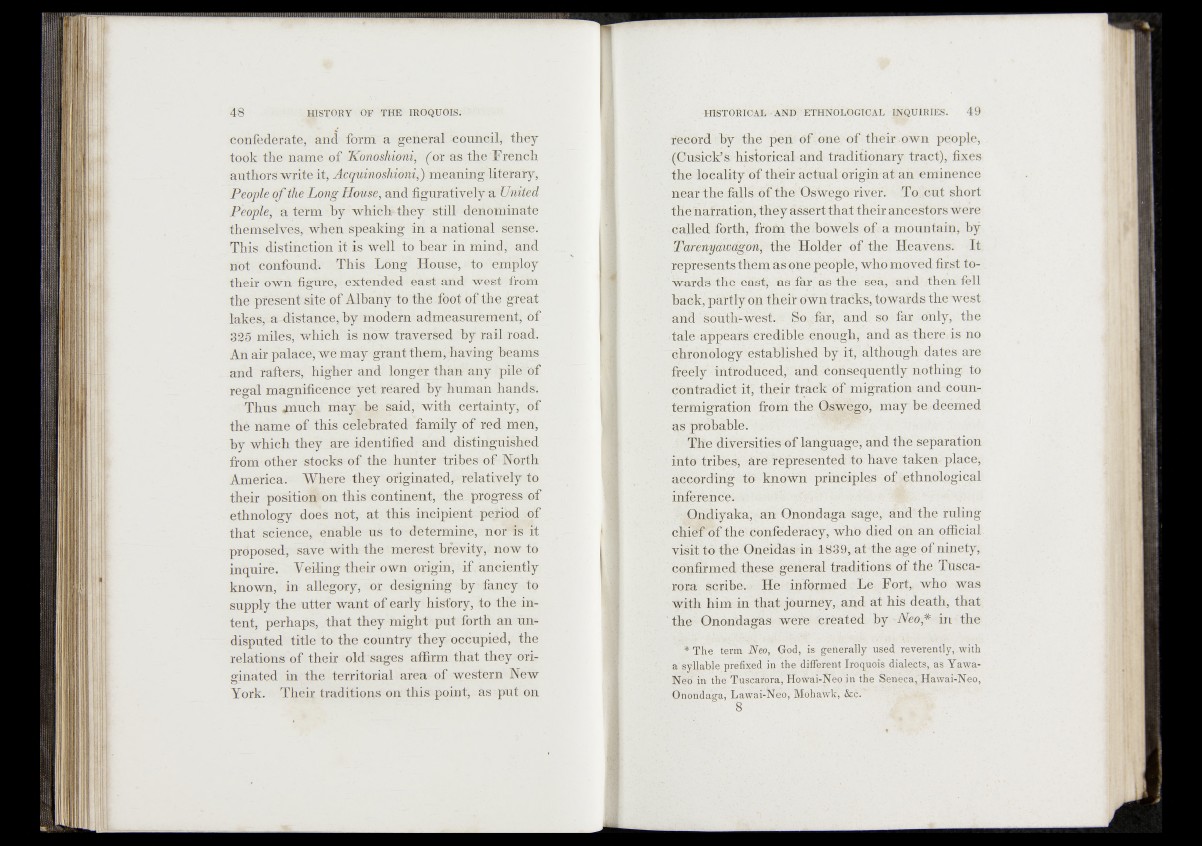
confederate, and form a general -council* tbéy
took the namepf Konoshioni, ( or as the'French
authors write it, Acquinoshidni^) meanin g; literary,
People of the Long House, and figur atively a United
People, a term by whicb4hey.^tiliLJ denominate
themselves* when speaking in a national sense.
This distinction it is well to bear in mind, and
Hot confound-. This Long House,Éto employ
their own figure, extended east and from
the .present site of Albany to the foot ofothe great
lakes,^-distance, by modem admeasurement of
32S miles, which is now traveréed by rail road.
An air palace, wé may grant them, having beams
and rafters, higher and longer than any ?pïté öf
regal magnificenCeryet reared^byjhuman hands*.
Thus much may, ba said, with mrtainty,‘ of
thé name of this celebrated, family of red men,
by which they .are identified and distinguished
from other stocks of the huiiteï tri'bes*of-®ferth
America. Where they originated^ relativelyfo
their position on this continent, the. .progress 'of
ethnology does not, at this incipient p e /i^ o f
that science, enable us to determine,vno?0® k
proposed, save with the '-merest brevity/now to
inquire. Veiling their own origin, >if .-anciently
known, in allegory, or designing by Hfancy , to
supply the utter want of early history, to the intent,
perhaps,. that they might ’ puti forth an um
disputed title to the country they occupied, the
relations of their oldsages affirm that theyori-
srinated in the territorial area of western Kew
York. Their traditions én this point, hs -put on
record by the pen of one of' their own people,
(Cusick’s historical and traditionary tract), fixes
the locality of their actual origin at an eminence
near the falls of the‘Oswego river. To cut short
the nafration, they assert that their ancestors Were
Called forth, from the bowels of a mountain, by
Parenydwagpnf the Holder of the Heavens: It
represents them as one people, who moved first towards
the east-- as .far, as the sea, and then, fell
hack, partly on their own tracks, towards the west
and South-west. ^o,vfar, and so far only, the
/tale appeais credible-enough; and as there,is no
Chronology established by it, although dates are
freely introduced; and consequently nothing to
Contradict it, their track ofomigration and counter
migration from the (Jswego, may be deemed
gs probable. .
The diversities of languages and the separation
* into tribes, Cre represented to have taken-place,
according to known principles ofjfthnological
inference. S*:
Qndiyaka, an Onondaga sage, and"the ruling
chfof of the confederacy, -who died on an official
visit to the Oneidas in 4839, at the age of ninety,
' confirmed these general traditions of the Tusca-
rora scribe..* He informed Le Fort,, who was
with him in that Journey, , and at his death, that
' the Onondaga» were Created by -in the
* The terih N&,' God, is generally used, revetently, with
a syllable prefixed in the different Iroqyois dialepts, as Yawa-
Neo in the Tuscarera’ Howai-Neo in the Seneca, Hawai-Neo,
Onondaga,' Lawai-Ndo, Tiloh a wk, &c.?
WBffl ‘fc